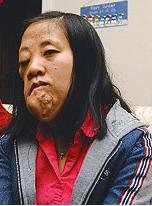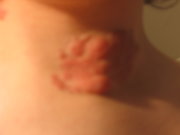CLEVELAND -- Both parents of an infant with cafe au lait spots should undergo an expert ophthalmic examination with a slit lamp to see if Lisch nodules are present, Dr. A. David Rothner said at a dermatology meeting sponsored by the Cleveland Clinic Foundation.
If these pigmented hamartomas of the iris are detected in either parent, the child may have inherited neurofibromatosis type 1 (NF1) and may need multiple specialty interventions to avert potentially disastrous complications such as lower-extremity amputation and stroke.
But the failure to establish a genetic association does not rule out the disorder. In only half of all cases of NF1 can inheritance be documented; the remainder are thought to be spontaneous mutations.
The condition, which occurs in roughly one out of 3,500 births, results from a large defect on chromosome 17 that produces abnormal development and migration of neural crest cells, said Dr. Rothner of the pediatric neurology department at the Cleveland Clinic. Inherited as an autosomal dominant condition, NF1 varies widely in expressivity, even in identical twins.
The diagnosis is a clinical one. "You cannot send blood for a chromosome study to diagnose this condition," Dr. Rothner said. "DNA mutational analysis would be needed, which is only available in research laboratories."
While the disorder ultimately may be associated with neurologic, ocular, skeletal, and other manifestations, cafe au lait spots often are the only clinical finding in infancy. The macules typically increase in size, number, and coloration as the child grows. Freckling in the inguinal and axillary regions also is typical.
Because the spots can be difficult to see in very young infants, the child's skin should be examined with a Wood's lamp. Other findings that should be looked for include skeletal abnormalities such as bowing of the tibia, congenital glaucoma and loss of visual acuity, as well as macrocephaly, he noted.
Treatment can be instituted as the findings warrant:
* For neurologic abnormalities. If the cafe au lait spots are the only manifestation of the disorder and no neurologic abnormalities are found, no treatment is indicated, though the child should be watched closely for changes in visual acuity and signs of increased intracranial pressure or spinal cord compression.
* For circulatory abnormalities. The disorder also may be associated with disorders of the blood vessels resulting in renal artery stenosis or pheochromocytoma and hypertension. Hemorrhage and stroke may occur if these conditions remain undetected and untreated.
* For limb defects. If deformities of the lower limbs are found, the child must wear braces. Fractures that result from tibial bowing heal poorly and in the past have often resulted in amputation.
* For learning disabilities. A very important aspect of following children with NF1, regardless of its clinical severity, is watching for abnormalities in mental development. "A very high percentage--35%--of these children are learning disabled," Dr. Rothner said. "As soon as I identify a child with NF1 who is not absolutely perfect in terms of development, I get that child into an early intervention program," he said.
* For malignancies. A late finding associated with NF1 is an increased incidence of breast cancer and other malignancies. "Anything growing fast should be biopsied," Dr. Rothner added.
Neurofibromatosis: Spotting Deafness
Once thought to be a variant of NF1, neurofibromatosis type 2 is now characterized as a separate disorder deriving from an abnormality on chromosome 22. This defect occurs once in every 50,000 live births.
"If you identify this condition early you can save the patient from a lifetime of deafness," Dr. Rothner said.
The cutaneous manifestations of NF2 appear as soft lipomatous lesions, possibly with some overlying hair.
Although patients who have NF2 may have multiple cutaneous and subcutaneous neurofibromas as well as spinal cord and brain tumors, the cardinal finding is the presence of bilateral tumors on the vestibular branch of the eighth nerve.
Patients who have these acoustic neuromas are likely to require lifelong attention from otologists and neurologists because of the complexity of management.
COPYRIGHT 2001 International Medical News Group
COPYRIGHT 2001 Gale Group




